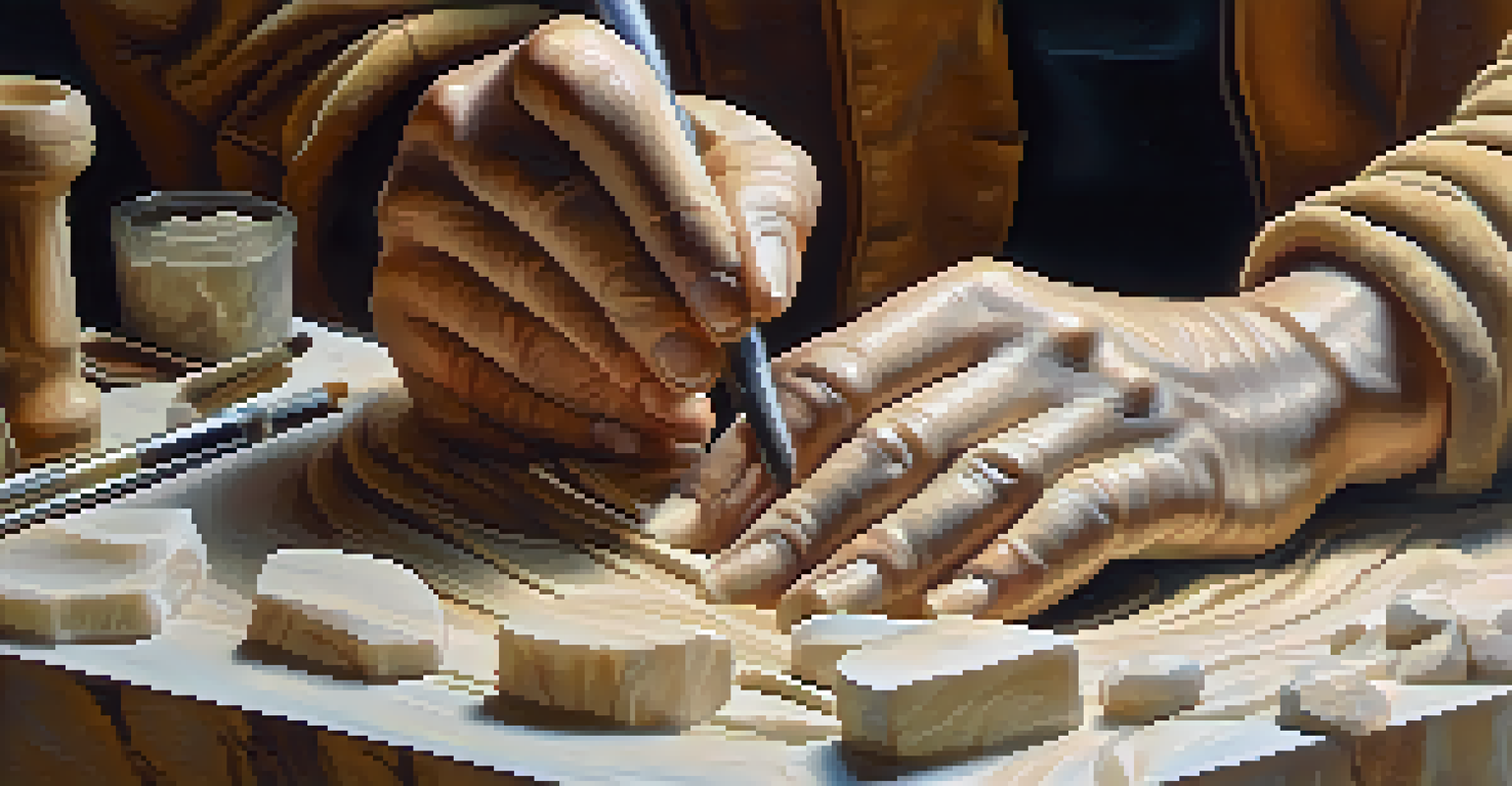Understanding Different Types of Stone for Carving Projects

Introduction to Stone Carving and Its Importance
Stone carving is an ancient art form that transforms raw materials into stunning sculptures. Understanding the different types of stone available is crucial for any artist, as each type brings its own unique qualities to a project. From the softness of soapstone to the durability of granite, knowing the characteristics of each stone can influence your design and technique.
Every artist dips his brush in his own soul, and paints his own nature into his pictures.
Choosing the right stone not only affects the final look of the artwork but also impacts the ease of carving. Beginners might prefer softer stones that allow for easier manipulation, while experienced carvers may seek out more challenging materials for advanced techniques. This exploration into various stones will help you make informed choices for your next carving project.
In this article, we will delve into the most popular types of stone used for carving, their distinct properties, and tips on how to work with them effectively. Whether you're a novice artist or a seasoned sculptor, understanding these materials will enhance your creative process.
Soapstone: The Beginner's Best Friend
Soapstone is often the go-to choice for beginners due to its soft and malleable nature. This metamorphic rock is primarily composed of talc, which allows for easy carving with minimal tools. Its smooth texture and ability to hold fine details make it an appealing option for those just starting out in the world of stone carving.

In addition to being easy to work with, soapstone is available in a variety of colors, including greens, grays, and browns. This versatility allows artists to create beautiful and unique pieces without the need for extensive finishing. Furthermore, soapstone is a non-porous material, which makes it ideal for kitchen items like countertops or sinks.
Choosing the Right Stone Matters
Selecting the appropriate stone enhances your artistic process and influences the overall outcome of your carving project.
While soapstone may not be as durable as harder stones, its ease of use and aesthetic appeal make it a fantastic choice for beginners. With practice, you'll gain confidence in your carving skills, and soapstone will become a valuable stepping stone in your artistic journey.
Alabaster: Beauty and Workability Combined
Alabaster is a stunningly beautiful stone that is favored by many sculptors for its translucence and rich color variations. This sedimentary rock is relatively soft, making it easy to carve, which is why it often attracts both beginners and experienced artists alike. Its ability to diffuse light adds a unique quality to any finished piece, making it a popular choice for decorative sculptures.
Art is not freedom from discipline, but disciplined freedom.
One of the key advantages of alabaster is its availability in a range of hues, from white and cream to vibrant reds and greens. This variety allows artists to explore different color palettes and styles in their work. However, due to its softness, alabaster can be more fragile than other stones, requiring careful handling during the carving process.
While alabaster may not be suitable for outdoor sculptures due to its tendency to weather, it excels in indoor projects where its delicate beauty can shine. Carving with alabaster can be incredibly rewarding, as the results are often breathtakingly beautiful.
Marble: The Classic Choice for Timeless Sculptures
Marble has long been celebrated as a premium material for sculpture, thanks to its durability and classic aesthetic. Renowned for its fine grain and ability to achieve a high polish, marble allows for intricate details and lifelike representations. This stone has been used for centuries in monumental works, showcasing its lasting appeal and versatility.
While marble is harder than soapstone and alabaster, it is still manageable for those with some carving experience. It requires more advanced tools and techniques, but the results can be stunning, with the ability to create smooth surfaces and delicate features. Many famous sculptures, like Michelangelo's David, are carved from marble, emphasizing its historical significance in the art world.
Beginner-Friendly Stones Available
Soft stones like soapstone and alabaster are ideal for beginners, offering easier manipulation and beautiful results without extensive tools.
However, working with marble does come with challenges, such as its tendency to chip or crack if not handled carefully. For artists willing to invest time and effort, marble can yield breathtaking results that stand the test of time, making it a classic choice for serious sculptors.
Granite: The Toughest Stone for Experienced Carvers
Granite is known for its incredible strength and durability, making it a preferred choice for large outdoor sculptures and monuments. This igneous rock is much harder than many other carving stones, which means it requires specialized tools and techniques. Because of its toughness, granite can withstand the elements, making it ideal for long-lasting works.
While granite can be challenging to carve, the results are often worth the effort. The stone comes in a variety of colors and patterns, allowing artists to create visually striking pieces that can stand out in any setting. Additionally, granite’s ability to hold detail can lead to impressive and intricate designs that showcase an artist's skill.
For those ready to tackle the challenge, working with granite can be a deeply satisfying experience. The process may require patience and precision, but the end result is a resilient and stunning sculpture that can be cherished for generations.
Limestone: A Versatile and Accessible Option
Limestone is another popular choice among carvers due to its accessibility and versatility. This sedimentary rock can be found in many regions, making it relatively easy to source for carving projects. Its softness allows for easy manipulation, similar to soapstone, which is why it’s often recommended for beginners and intermediate carvers.
The color palette of limestone ranges from light creams to darker grays, providing a neutral backdrop for various artistic styles. While it may not have the same level of durability as granite or marble, limestone can still be used for both indoor and outdoor projects, as long as it is properly sealed to withstand moisture.
Advanced Techniques with Hard Stones
Experienced carvers can explore challenging materials like marble and granite, which require specialized tools but yield stunning and durable sculptures.
Limestone is not only user-friendly but also rich in history, as many ancient structures and monuments were built from this stone. Carving in limestone allows artists to connect with the past while creating contemporary works that resonate with modern audiences.
Basalt: The Unique Choice for Distinctive Projects
Basalt is a volcanic rock that offers a unique and rugged aesthetic, making it an intriguing choice for sculptors looking for something different. Its dark color and dense texture can create dramatic pieces that stand out in any setting. While basalt is harder to carve than softer stones, it can yield stunning results that showcase an artist's creativity.
Due to its composition, carving basalt requires specialized tools, as traditional techniques may not be effective. However, for those willing to learn and adapt, working with basalt can be incredibly rewarding. The stone's durability makes it suitable for outdoor sculptures, ensuring that the artwork can withstand the elements.

Artists often use basalt to create modern and abstract pieces, taking advantage of its unique textures and colors. If you're looking to break away from traditional stones, basalt might just inspire you to explore new artistic horizons.
Conclusion: Choosing the Right Stone for Your Project
Selecting the right stone for your carving project is essential to achieving your artistic vision. Each type of stone offers different qualities that can enhance or hinder your creative process, so it's important to consider your skill level, the desired outcome, and the tools available. Whether you're drawn to the softness of soapstone or the challenge of granite, each choice carries its own rewards.
As you embark on your carving journey, don't hesitate to experiment with various stones to discover which resonates with your style and technique. Each stone has its own story and personality, waiting to be revealed through your artistry. Embrace the learning curve, and allow each project to guide you to new skills and insights.
Ultimately, the joy of stone carving lies not only in the final piece but in the process of creation itself. With each stroke, you have the opportunity to connect with the material and express your unique vision, bringing your artistic dreams to life.